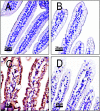The cytokine osteopontin modulates the severity of rotavirus diarrhea
- PMID: 15731245
- PMCID: PMC1075680
- DOI: 10.1128/JVI.79.6.3509-3516.2005
The cytokine osteopontin modulates the severity of rotavirus diarrhea
Abstract
Osteopontin (OPN) is a sialated phosphoprotein found in tissues and secreted into body fluids. It is an integrin ligand with pleiotropic functions as an extracellular matrix protein in mineralized tissues and a cytokine that is active in cell signaling (A. B. Tuck, C. Hota, S. M. Wilson, and A. F. Chambers, Oncogene 22:1198-1205, 2003). To determine whether OPN may be important in mucosal defense against viral pathogens, we evaluated the OPN response to rotavirus infection and the extent of diarrhea manifested by infected opn null mutant (opn-/-) mice. Reverse transcription-PCR, Northern and Western blots, and immunohistochemical studies of the HT-29 intestinal epithelial cell line and murine intestine were used to evaluate OPN mRNA and product. Intestinal closed loops and diarrheal observations determined disease severity and duration. OPN mRNA levels increased after infection of HT-29 cells, peaking in 4 to 6 h. Infected cultures contained 925 microg of OPN/ml, while for controls the levels were below detection (50 microg/ml). Infection increased OPN mRNA levels in intestinal tissue between 2 and 24 h postinoculation and increased OPN protein in intestinal fluid. The cellular localization of OPN was supranuclear and apical, and responding cells were diffusely distributed on the villus surface. Three days after infection, closed intestinal loops from opn-/- mice contained more fluid than loops from controls, although secretion levels at the onset of illness were similar. Null mutant mice experienced more intense and prolonged diarrhea than controls. Rotavirus infection of intestinal epithelial cells and murine intestine caused marked increases in OPN mRNA levels and secreted OPN protein. OPN-deficient mice suffered prolonged disease.
Figures





Similar articles
-
Antiviral effects of cyclosporine A in neonatal mice with rotavirus-induced diarrhea.J Pediatr Gastroenterol Nutr. 2015 Jan;60(1):11-7. doi: 10.1097/MPG.0000000000000493. J Pediatr Gastroenterol Nutr. 2015. PMID: 25061717
-
Detailed analysis of BALB/c mice challenged with wild type rotavirus EDIM provide an alternative for infection model of rotavirus.Virus Res. 2017 Jan 15;228:134-140. doi: 10.1016/j.virusres.2016.12.001. Epub 2016 Dec 5. Virus Res. 2017. PMID: 27932206
-
Effect of osteopontin on diarrhea duration and innate immunity in suckling mice infected with a murine rotavirus.Viral Immunol. 2009 Apr;22(2):139-44. doi: 10.1089/vim.2008.0054. Viral Immunol. 2009. PMID: 19327001
-
Pathogenesis of rotavirus diarrhea.Microbes Infect. 2001 Nov;3(13):1145-56. doi: 10.1016/s1286-4579(01)01475-7. Microbes Infect. 2001. PMID: 11709295 Free PMC article. Review.
-
Rotavirus pathology and pathophysiology.Curr Top Microbiol Immunol. 1994;185:255-83. doi: 10.1007/978-3-642-78256-5_9. Curr Top Microbiol Immunol. 1994. PMID: 8050281 Review. No abstract available.
Cited by
-
Dietary osteopontin-enriched algal protein as nutritional support in weaned pigs infected with F18-fimbriated enterotoxigenic Escherichia coli.J Anim Sci. 2020 Oct 1;98(10):skaa314. doi: 10.1093/jas/skaa314. J Anim Sci. 2020. PMID: 32954424 Free PMC article.
-
T-bet-dependent expression of osteopontin contributes to T cell polarization.Proc Natl Acad Sci U S A. 2005 Nov 22;102(47):17101-6. doi: 10.1073/pnas.0508666102. Epub 2005 Nov 14. Proc Natl Acad Sci U S A. 2005. PMID: 16286640 Free PMC article.
-
Forward genetic dissection of innate response to infection in inbred mouse strains: selected success stories.Clin Exp Immunol. 2010 Dec;162(3):393-401. doi: 10.1111/j.1365-2249.2010.04249.x. Clin Exp Immunol. 2010. PMID: 21070206 Free PMC article. Review.
-
Matricellular proteins in cardiac adaptation and disease.Physiol Rev. 2012 Apr;92(2):635-88. doi: 10.1152/physrev.00008.2011. Physiol Rev. 2012. PMID: 22535894 Free PMC article. Review.
-
Acute oxidative stress affects IL-8 and TNF-α expression in IPEC-J2 porcine epithelial cells.Inflammation. 2012 Jun;35(3):994-1004. doi: 10.1007/s10753-011-9403-8. Inflammation. 2012. PMID: 22083491
References
-
- Ashkar, S., G. F. Weber, V. Panoutsakopoulou, M. E. Sanchirico, M. Jansson, S. Zawaideh, S. R. Rittling, D. T. Denhardt, M. J. Glimcher, and H. Cantor. 2000. Eta-1 (osteopontin): an early component of type-1 (cell-mediated) immunity. Science 287:860-864. - PubMed
-
- Bayless, K. J., G. A. Meininger, J. M. Scholtz, and G. E. Davis. 1998. Osteopontin is a ligand for the alpha4beta1 integrin. J. Cell Sci. 111:1165-1174. - PubMed
-
- Bishop, R. F., G. P. Davidson, I. H. Holmes, and B. J. Ruck. 1973. Virus particles in epithelial cells of duodenal mucosa from children with viral gastroenteritis. Lancet 2:1281-1283. - PubMed
-
- Boshuizen, J. A., J. H. Reimerink, A. M. Korteland-van Male, V. J. van Ham, M. P. Koopmans, H. A. Buller, J. Dekker, and A. W. Einerhand. 2003. Changes in small intestinal homeostasis, morphology, and gene expression during rotavirus infection of infant mice. J. Virol. 77:13005-13016. - PMC - PubMed
Publication types
MeSH terms
Substances
LinkOut - more resources
Full Text Sources
Other Literature Sources
Medical
Molecular Biology Databases
Research Materials
Miscellaneous

